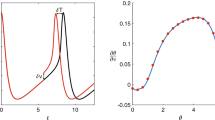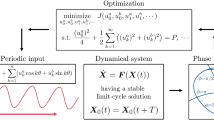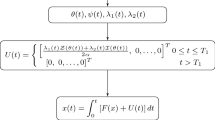Abstract
Optimization and control of collective dynamics in rhythmic systems have attracted increasing interest, and various methods have been developed on the basis of the phase reduction framework for limit cycle oscillators. The phase reduction relies on the notion of the isochron, which represents the set of system states that share the same asymptotic phase. However, the phase reduction does not take into account the amplitude degrees of freedom representing deviations of the system state from the limit cycle attractor, to which some rich and nontrivial transient behaviors of the oscillators are attributed. In this chapter, after a brief introduction of the phase reduction framework, a phase-amplitude reduction framework that is applicable to transient dynamics far from the limit cycle attractor is formulated. A rigorous theoretical background for defining the amplitudes is provided by the notion of the isostable, which naturally complements the isochron in the sense that both of them can be understood from a unified viewpoint of the spectral properties of the Koopman operator. The utility of the proposed phase-amplitude reduction framework is illustrated by evaluating the optimal injection timing of a weak control input that efficiently suppresses deviations of the system state from the limit cycle attractor.
Access this chapter
Tax calculation will be finalised at checkout
Purchases are for personal use only
Similar content being viewed by others
References
Abraham, I., De la Torre, G., Murphey, T.D.: Model-based control using Koopman operators. In: Proceedings of Robotics: Science and Systems (2017)
Acebrón, J.A., Bonilla, L.L., Pérez Vincente, C.J., Ritort, F., Spigler, R.: The Kuramoto model: a simple paradigm for synchronization phenomena. Rev. Mod. Phys. 77 (2005)
Aranson, I.S., Kramer, L.: The world of the complex Ginzburg-Landau equation. Rev. Mod. Phys. 74 (2002)
Ashwin, P., Coombes, S., Nicks, R.: Mathematical frameworks for oscillatory network dynamics in neuroscience. J. Math. Neurosci. 6 (2016)
Brown, E., Moehlis, J., Holmes, P.: On the phase reduction and response dynamics of neural oscillator populations. Neural Comput. 16 (2004)
Brunton, S.L., Brunton, B.W., Proctor, J.L., Kutz, J.N.: Koopman invariant subspaces and finite linear representations of nonlinear dynamical systems for control. PLoS ONE 11 (2016)
Budišić, M., Mohr, R., Mezić, I.: Applied Koopmanism. Chaos 22 (2012)
Castejón, O., Guillamon, A., Huguet, G.: Phase-Amplitude response functions for transient-state stimuli. J. Math. Neurosci. 3 (2013)
Colonius, F., Kliemann, W.: Dynamical Systems and Linear Algebra. American Mathematical Society, Providence (2014)
Cross, M.C., Hohenberg, P.C.: Pattern formation outside of equilibrium. Rev. Mod. Phys. 65 (1993)
Dasanayake, I., Li, J.-S.: Optimal design of minimum-power stimuli for phase models of neuron oscillators. Phys. Rev. E 83 (2011)
Dörfler, F., Chertkov, M., Bullo, F.: Synchronization in complex oscillator networks and smart grids. Proc. Natl. Acad. Sci. USA 110 (2013)
Dörfler, F., Bullo, F.: Synchronization in complex networks of phase oscillators: a survey. Proc. Autom. 50 (2014)
Eldering, J., Kvalheim, M., Revzen, S.: Global linearization and fiber bundle structure of invariant manifolds. Nonlinearity 31 (2018)
Ermentrout, G.B.: Type I membranes, phase resetting curves, and synchrony. Neural Comput. 8 (1996)
Ermentrout, B., Park, T., Wilson, D.: Recent advances in coupled oscillator theory. Philos. Trans. R. Soc. A 377 (2019)
Ermentrout, G.B., Terman, D.H.: Mathematical Foundations of Neuroscience. Springer, New York (2010)
Froyland, G., Hüls, T., Morriss, G.P., Watson, T.M.: Computing covariant Lyapunov vectors, Oseledets vectors, and dichotomy projectors: a comparative numerical study. Phys. D 247 (2013)
Gaeta, G.: Poincaré Normal and Renormalized Forms. Acta Appl. Math. 70 (2002)
Goldobin, D.S., Teramae, J.-N., Nakao, H., Ermentrout, G.B.: Dynamics of limit-cycle oscillators subject to general noise. Phys. Rev. Lett. 105 (2010)
Goswami, D., Paley, D.A.: Global bilinearization and controllability of control-affine nonlinear systems: a Koopman spectral approach. In: 56th Annual Conference on Decision and Control pp. 6107–6112 (2017)
Guckenheimer, J., Holmes, P.J.: Nonlinear Oscillations, Dynamical Systems, and Bifurcations of Vector Fields. Springer, New York (1983)
Hale, J.K.: Ordinary Differential Equations. Dover Publications, New York (2009)
Harada, T., Tanaka, H.-A., Hankins, M.J., Kiss, I.Z.: Optimal waveform for the entrainment of a weakly forced oscillator. Phys. Rev. Lett. 105 (2010)
Hitczenko, P., Medvedev, G.S.: The Poincaré map of randomly perturbed periodic motion. J. Nonlinear Sci. 23 (2013)
Hoppensteadt, F.C., Izhikevich, E.M.: Weakly Connected Neural Networks. Springer, New York (1997)
Hoppensteadt, F.C.: Analysis and Simulation of Chaotic Systems. Springer, New York (2000)
Hüls, T.: Computing stable hierarchies of fiber bundles. Discret. Contin. Dyn. Syst. Ser. B 22 (2017)
Kaiser, E., Kutz, J.N., Brunton, S.L.: Data-driven discovery of Koopman eigenfunctions for control (2017). arXiv:1707.01146
Kawamura, Y., Nakao, H.: Collective phase description of oscillatory convection. Chaos 23D (2013)
Kawamura, Y., Shirasaka, S., Yanagita, T., Nakao, H.: Optimizing mutual synchronization of rhythmic spatiotemporal patterns in reaction-diffusion systems. Phys. Rev. E 96 (2017)
Keener, J.P.: Principles of Applied Mathematics. Westview Press, Boulder (2001)
Keener, J., Sneyd, J.: Mathematical Physiology I: Cellular Physiology. Springer, New York (2009)
Kiss, I.Z., Rusin, C.G., Kori, H., Hudson, J.L.: Engineering complex dynamical structures: sequential patterns and desynchronization. Science 316 (2007)
Korda, M., Mezic, I.: Linear predictors for nonlinear dynamical systems: Koopman operator meets model predictive control. Automatica 93 (2018)
Koseska, A., Volkov, E., Kurths, J.: Oscillation quenching mechanisms: amplitude vs. oscillation death. Phys. Rep. 531 (2013)
Kotani, K., Yamaguchi, I., Ogawa, Y., Jimbo, Y., Nakao, H., Ermentrout, G.B.: Adjoint method provides phase response functions for delay-induced oscillations. Phys. Rev. Lett. 109 (2012)
Kowalski, K., Steeb, W.H.: Nonlinear Dynamical Systems and Carleman Linearization. World Scientific, Singapore (2011)
Kuptsov, P.V., Parlitz, U.: Theory and computation of covariant Lyapunov vectors. J. Nonlinear Sci. 22 (2012)
Kuramoto, Y.: Self-entrainment of a population of coupled non-linear oscillators. In: Arakaki, H. (ed.) International Symposium on Mathematical Problems in Theoretical Physics. Lecture Notes in Physics, vol. 39. Springer, New York (1975)
Kuramoto, Y.: Chemical Oscillations, Waves, and Turbulence. Springer, Berlin (1984)
Kvalheim, M.D., Revzen, S.: Existence and uniqueness of global Koopman eigenfunctions for stable fixed points and periodic orbits (2019). arXiv:1911.11996
Lan, Y., Mezić, I.: Linearization in the large of nonlinear systems and Koopman operator spectrum. Phys. D 242 (2013)
Li, Q., Dietrich, F., Bollt, E.M., Kevrekidis, I.G.: Extended dynamic mode decomposition with dictionary learning: a data-driven adaptive spectral decomposition of the Koopman operator. Chaos 27 (2017)
Lusch, B., Kutz, J.N., Brunton, S.L.: Deep learning for universal linear embeddings of nonlinear dynamics. Nat. Commun. 9 (2018)
Malkin, I.G.: Some Problems in Nonlinear Oscillation Theory. Gostexizdat, Moskow (1956). (in Russian)
Mardt, A., Pasquali, L., Wu, H., Noé, F.: VAMPnets for deep learning of molecular kinetics. Nat. Commun. 9 (2018)
Matthews, P.C., Mirollo, R.E., Strogatz, S.H.: Dynamics of a large system of coupled nonlinear oscillators. Phys. D 52 (1991)
Mauroy, A., Mezić, I.: On the use of Fourier averages to compute the global isochrons of (quasi)periodic dynamics. Chaos 22 (2012)
Mauroy, A., Mezić, I.: Global computation of phase-amplitude reduction for limit-cycle dynamics. Chaos 28 (2018)
Mauroy, A., Mezić, I., Moehlis, J.: Isostables, isochrons, and Koopman spectrum for the action-angle representation of stable fixed point dynamics. Phys. D 261 (2013)
Mauroy, A., Rhoads, B., Moehlis, J., Mezic, I.: Global isochrons and phase sensitivity of bursting neurons. SIAM J. Appl. Dyn. Syst. 13 (2014)
Mauroy, A.: Converging to and escaping from the global equilibrium: isostables and optimal control. In: Proceedings of the 53rd IEEE Conference on Decision and Control, pp. 5888–5893 (2014)
Mezić, I.: Analysis of fluid flows via spectral properties of the Koopman operator. Ann. Rev. Fluid Mech. 45 (2013)
Mezić, I.: Spectum of the Koopman Operator, Spectral Expansions in Functional Spaces, and State-Space Geometry. J. Nonlinear Sci. (2019)
Mikhailov, A.S., Ertl, G.: Chemical Complexity. Springer International Publishing, Cham (2017)
Moehlis, J., Shea-Brown, E., Rabitz, H.: Optimal inputs for phase models of spiking neurons. J. Comput. Nonlinear Dyn. 1 (2006)
Mohr, R., Mezić, I.: Construction of eigenfunctions for scalar-type operators via Laplace averages with connections to the Koopman operator (2014). arXiv:1403.6559
Monga, B., Wilson, D., Matchen, T., Moehlis, J.: Phase reduction and phase-based optimal control for biological systems: a tutorial. Biol. Cybern. (2018)
Nakao, H.: Phase reduction approach to synchronisation of nonlinear oscillators. Contemp. Phys. 57 (2016)
Nakao, H., Mikhailov, A.S.: Diffusion-induced instability and chaos in random oscillator networks. Phys. Rev. E 79 (2009)
Nakao, H., Yanagita, T., Kawamura, Y.: Phase reduction approach to synchronization of spatiotemporal rhythms in reactiondiffusion systems. Phys. Rev. X 4 (2014)
Novičenko, V., Pyragas, K.: Phase reduction of weakly perturbed limit cycle oscillations in time-delay systems. Phys. D 241 (2012)
Otto, S.E., Rowley, C.W.: Linearly recurrent autoencoder networks for learning dynamics. SIAM J. Appl. Dyn. Syst. 18 (2019)
Park, Y., Shaw, K.M., Chiel, H.J., Thomas, P.J.: The infinitesimal phase response curves of oscillators in piecewise smooth dynamical systems. Eur. J. Appl. Math. 29 (2018)
Pikovsky, A., Rosenblum, M., Kurths, J.: Synchronization: A Universal Concept in Nonlinear Sciences. Cambridge University Press, Cambridge (2003)
Pikovsky, A.: Maximizing coherence of oscillations by external locking. Phys. Rev. Lett. 115 (2015)
Pikovsky, A., Politi, A.: Lyapunov Exponents: A Tool to Explore Complex Dynamics. Cambridge University Press, Cambridge (2015)
Proctor, J.L., Brunton, S.L., Kutz, J.N.: Dynamic mode decomposition with control. SIAM J. Appl. Dyn. Syst. 15 (2016)
Rodrigues, F.A., Peron, T.K.DM., Ji, P., Kurths, J.: The Kuramoto model in complex networks. Phys. Rep. 610 (2016)
Rowley, C.W., Mezić, I., Bagheri, S., Schlatter. P., Henningson, D.S.: Spectral analysis of nonlinear flows. J. Fluid Mech. 641 (2009)
Sanders, J.A., Verhulst, F., Murdock, J.: Averaging Methods in Nonlinear Dynamical Systems. Springer, New York (2007)
Schmid, P.J.: Dynamic mode decomposition of numerical and experimental data. J. Fluid Mech. 656 (2010)
Schultheiss, N.W., Prinz, A.A., Butera, R.J. (eds.): Phase Response Curves in Neuroscience: Theory, Experiment, and Analysis. Springer, New York (2011)
Shilnilov, L.P., Shilnilov, A.L., Turaev, D.V., Chua, L.O.: Methods of Qualitative Theory in Nonlinear Dynamics. Part I. World Scientific, Singapore (1998)
Shirasaka, S., Watanabe, N., Kawamura, Y., Nakao, H.: Optimizing stability of mutual synchronization between a pair of limit-cycle oscillators with weak cross coupling. Phys. Rev. E 96 (2017)
Shirasaka, S., Kurebayashi, W., Nakao, H.: Phase reduction theory for hybrid nonlinear oscillators. Phys. Rev. E 95 (2017)
Shirasaka, S., Kurebayashi, W., Nakao, H.: Phase-amplitude reduction of transient dynamics far from attractors for limit-cycling systems. Chaos 27 (2017)
Skardal, P.S., Taylor, D., Sun, J.: Optimal synchronization of complex networks. Phys. Rev. Lett. 113 (2014)
Skardal, P.S., Taylor, D., Sun, J.: Optimal synchronization of directed complex networks. Chaos 26 (2016)
Sootla, A., Mauroy, A., Ernst, D.: Optimal control formulation of pulse-based control using Koopman operator. Automatica 91 (2018)
Stankovski, T., Pereira, T., McClintock, P.V.E., Stefanovska, A.: Coupling functions: universal insights into dynamical interaction mechanisms. Rev. Mod. Phys. 89 (2017)
Strogatz, S.H.: From Kuramoto to Crawford: exploring the onset of synchronization in populations of coupled oscillators. Phys. D 143 (2000)
Strogatz, S.H., Abrams, D.M., McRobie, A., Eckhardt, B., Ott, E.: Crowd synchrony on the Millennium bridge. Nature 438 (2005)
Strogatz, S.H.: Nonlinear Dynamics and Chaos: With Applications to Physics, Biology, Chemistry, and Engineering. Westview press, Boulder (2014)
Taira, K., Nakao, H.: Phase-response analysis of synchronization for periodic flows. J. Fluid. Mech. 846 (2018)
Takeishi, N., Kawahara, Y., Yairi, Y.: Learning koopman invariant subspaces for dynamic mode decomposition. In: Advances in Neural Information Processing Systems, pp. 1130–1140 (2017)
Tass, P.A.: Phase Resetting in Medicine and Biology: Stochastic Modelling and Data Analysis. Springer, Berlin (2007)
Tinsley, M.R., Nkomo, S., Showalter, K.: Chimera and phase-cluster states in populations of coupled chemical oscillators. Nat. Phys. 8 (2012)
Traversa, F.L., Bonnin, M., Corinto, F., Bonani, F.: Noise in oscillators: a review of state space decomposition approaches. J. Comput. Electron. 14 (2015)
Tu, J.H., Rowley, C.W., Luchtenburg, D.M., Brunton, S.L., Kutz, J.N.: On dynamic mode decomposition: theory and applications. J. Comput. Dyn. 1 (2014)
Watanabe, N., Kato, Y., Shirasaka, S., Nakao, H.: Optimization of linear and nonlinear interaction schemes for stable synchronization of weakly coupled limit-cycle oscillators. Phys. Rev. E 100 (2019)
Wedgwood, K.C.A., Lin, K.K., Thul, R., Coombes, S.: Phase-amplitude descriptions of neural oscillator models. J. Math. Neurosci. 3 (2013)
Wiggins, S.: Introduction to Applied Nonlinear Dynamical Systems and Chaos. Springer, New York (2003)
Williams, M.O., Kevrekidis, I.G., Rowley, C.W.: A DataDriven approximation of the Koopman operator: extending dynamic mode decomposition. J. Nonlinear Sci. 25 (2015)
Williams, M.O., Rowley, C.W., Kevrekidis, I.G.: A kernel-based method for data-driven koopman spectral analysis. J. Comput. Dyn. 2015 (2015)
Wilson, D.: Isostable reduction of oscillators with piecewise smooth dynamics and complex Floquet multipliers. Phys. Rev. E 99 (2019)
Wilson, D., Ermentrout, G.B.: Greater accuracy and broadened applicability of phase reduction using isostable coordinates. J. Math. Biol. 76 (2018)
Wilson, D., Ermentrout, B.: Phase Models Beyond Weak Coupling. Phys. Rev. Lett. 123 (2019)
Wilson, D., Holt, A.B., Netoff, T.I., Moehlis, J.: Optimal entrainment of heterogeneous noisy neurons. Front. Neurosci. 29 (2015)
Wilson, D., Moehlis, J.: Extending phase reduction to excitable media: theory and applications. SIAM Rev. 57 (2015)
Wilson, D., Moehlis, J.: Isostable reduction with applications to time-dependent partial differential equations. Phys. Rev. E 94 (2016)
Wilson, D., Moehlis, J.: Isostable reduction of periodic orbits. Phys. Rev. E 94 (2016)
Wilson, D., Moehlis, J.: Spatiotemporal control to eliminate cardiac alternans using isostable reduction. Phys. D 342 (2017)
Winfree, A.T.: The Geometry of Biological Time. Springer, New York (2001)
Yeung, E., Kundu, S., Hodas, N.: Learning Deep Neural Network Representations for Koopman Operators of Nonlinear Dynamical Systems. In: 2019 American Control Conference, pp. 4832–4839 (2019)
Yoshimura, K., Arai, K.: Phase reduction of stochastic limit cycle oscillators. Phys. Rev. Lett. 101 (2008)
Zlotnik, A., Chen, Y., Kiss, I.Z., Tanaka, H.-A., Li, J.-S.: Optimal waveform for fast entrainment of weakly forced nonlinear oscillators. Phys. Rev. Lett. 111 (2013)
Zlotnik, A., Nagao, R., Kiss, I.Z., Li, J.-S.: Phase-selective entrainment of nonlinear oscillator ensembles. Nat. Commun. 7 (2016)
Acknowledgements
S. S. acknowledges financial support from Japan Society for the Promotion of Science (JSPS) KAKENHI Grant No. 18H06478. W. K. acknowledges financial support from JSPS KAKENHI Grants No. 16K16125 No. 17H03279. H. N. acknowledges financial support from JSPS KAKENHI Grants No. 16K13847, No. 17H03279, No. 18K03471, No. 18H03287, and JST CREST Grant No. JPMJCR1913.
Author information
Authors and Affiliations
Corresponding author
Editor information
Editors and Affiliations
Appendix: Laplace Average
Appendix: Laplace Average
In this appendix, we propose a simpler version of the Laplace average [49, 54]. The following results also hold for complex Koopman eigenvalues \(\lambda \). When \(\mathbf {F}\) is a nonresonant analytic vector field, a generic scalar-valued observable function f can be expressed as [55]
where \(\mathbf {m}=(m_2,m_3,\ldots ,m_N)\). The complex coefficients \(a_{k,\mathbf {m}}(f) \in \mathbb {C}\) are called the Koopman modes, \(\lambda _{k,\mathbf {m}} = k\lambda _1 + \sum _{i=2}^N{m_i \lambda _{i}}\) are the eigenvalues of the infinitesimal generator of the Koopman operator semigroup, and
are their associated eigenfunctions. When the observable can be expanded as (15.65), we can evaluate the value of a Koopman eigenfunction at point \(\mathbf {x}\) by using the generalized Laplace average [54] as
where \(\mathrm{Re}(\lambda )\) is the real part of \(\lambda \).
If we evaluate the value of the Jth principal Koopman eigenfunction associated with the Floquet exponent \(\text{ Re } (\lambda _J) \; (> 2 \text{ Re } (\lambda _2))\), we can simplify the generalized Laplace average using an observable \(g_J\) defined as
where \(\theta _* = \theta (\mathbf {x})\). Since this observable converges to zero along a transient orbit, we obtain \(a_{k,\mathbf {0}}(g_J)=0\) for all \(k\in \mathbb {Z}\), where \(\mathbf {0}\) is a zero vector. The gradient of \(g_J\) evaluated on the periodic orbit \(\chi \) is given by
where \(\mathbf {I}\) is the identity matrix and we used the fact [41, Sect. 3.4] that \(\mathbf {F}(\mathbf {x}_0(\theta _*))\) is parallel to \({\varvec{\gamma }}_1(\mathbf {x}_0(\theta _*))\) and the bi-orthogonal relation (15.51).
Let us denote a vector which has a nonzero element of value q only at the \((p-1)\)th component as \(\mathbf {m}_{p,q}\). Because \(r_p=0\) on \(\chi \), the gradient of f evaluated on \(\chi \) contains the following terms corresponding to \(\mathbf {m}_{p,1}\):
It can be easily shown that all other components corresponding to \(|\mathbf {m}|_1 \ge 2\), where \(|\cdot |_1\) is the \(l^1\)-norm, do not contribute to the gradient \(\nabla f\) on \(\chi \) since \(r_p=0\) on the periodic orbit. We can then obtain the Koopman modes \(a_{k,\mathbf {m}_{p,1}}(f)\) for the generic observable f from its gradient evaluated on the periodic orbit \(\chi \) as follows. First, we take a phase-wise inner product of \(\nabla f(\mathbf {x}_0(\theta _*))\) and \(e^{-\mathrm{i}k \theta _* } {\varvec{\gamma }}_p(\mathbf {x}_0(\theta _*))\), which we denote by \(\tilde{z}(\theta _*)\). Then we evaluate the average of \(\tilde{z}(\theta _*)\) over the circle. From Eq. (15.69), there is only one nonzero Koopman mode for \(|\mathbf {m}|_1 \le 1\), i.e., \(a_{0,\mathbf {m}_{J,1}}(g_J)=1\) for the observable \(g_J\). In general, the Koopman modes associated with the non-principal eigenfunctions with \(|\mathbf {m}|_1 \ge 2\) are nonzero even for the observable \(g_J\). However, when \(\text{ Re } (\lambda _J) \; > 2 \text{ Re } (\lambda _2)\) holds, all the Koopman modes \(a_{k,\mathbf {m}'}(g_J)\) involved in the generalized Laplace average (15.67) are zero.
Thus, we can replace the generalized Laplace average with the following Laplace average when we evaluate the Jth principal Koopman eigenfunction:
Rights and permissions
Copyright information
© 2020 Springer Nature Switzerland AG
About this chapter
Cite this chapter
Shirasaka, S., Kurebayashi, W., Nakao, H. (2020). Phase-Amplitude Reduction of Limit Cycling Systems. In: Mauroy, A., Mezić, I., Susuki, Y. (eds) The Koopman Operator in Systems and Control. Lecture Notes in Control and Information Sciences, vol 484. Springer, Cham. https://doi.org/10.1007/978-3-030-35713-9_15
Download citation
DOI: https://doi.org/10.1007/978-3-030-35713-9_15
Published:
Publisher Name: Springer, Cham
Print ISBN: 978-3-030-35712-2
Online ISBN: 978-3-030-35713-9
eBook Packages: Intelligent Technologies and RoboticsIntelligent Technologies and Robotics (R0)




